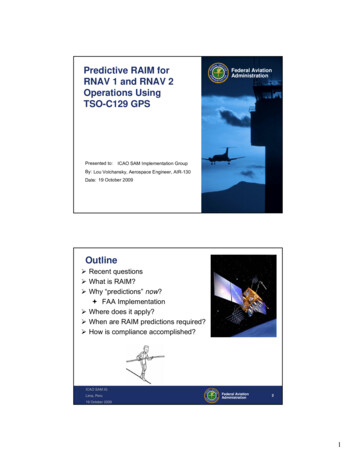
Transcription
Predictive RAIM forRNAV 1 and RNAV 2Operations UsingTSO-C129 GPSPresented to:Federal AviationAdministrationICAO SAM Implementation GroupBy: Lou Volchansky, Aerospace Engineer, AIR-130Date: 19 October 2009Outline¾ Recent questions¾ What is RAIM?¾ Why “predictions” now? FAA Implementation¾ Where does it apply?¾ When are RAIM predictions required?¾ How is compliance accomplished?ICAO SAM IGLima, PeruFederal AviationAdministration219 October 20091
Questions from past 6 months¾¾¾¾Why worry about working satellites?What about getting “fleet credit”?Why isn’t prior service history given more credit?Why can’t baro-aiding be used as a baseline?ICAO SAM IGLima, PeruFederal AviationAdministration319 October 2009Recently Submitted Questions¾ What is the difference between: Global Navigation Satellite System (GNSS)monitoring status? Addressed through published GPSNotices to Airmen (NOTAMS). Who records? USCoast Guard Who gets data? Requesting user How isit used in flight operations? RAIM calculation GPS data recording? State requirement to record GPSdata in case of incident/accident. How does US handle? Ground real-time monitoring status? What isdifference from GNSS monitoring? RAIM prediction monitoring? Based on current GPSconstellation status.ICAO SAM IGLima, PeruFederal AviationAdministration419 October 20092
Recently Submitted Questions¾ Is RAIM prediction done for fault detection (FD),fault detection and exclusion (FDE), andPerformance Navigation for the operation en route,terminal and non-precision approach (NPA)? Fault Detection only, but also includes option forbaro-aiding¾ Is one RAIM prediction performed, or one for eachcase? U.S. Ops requirement for en route and terminalRAIM prediction. Non-precision approach (NPA)provided, but not requiredICAO SAM IGLima, PeruFederal AviationAdministration519 October 2009Recently Submitted Questions¾ Who conducts the RAIM prediction, the ServiceProvider or the Operator? What type ofconsideration is necessary to analyze at thisrespect? In the US, the FAA established 6 means ofcompliance (discussed in briefing)¾ How will RAIM prediction consider solarphenomena? How will predictions be calculated? FAA's RAIM prediction does not focus on solar flareinfluence (discussed in briefing)ICAO SAM IGLima, PeruFederal AviationAdministration619 October 20093
What is RAIM?¾ Receiver Autonomous Integrity Monitoring Means of providing GPS signal integrity monitoring Need 5 satellites for fault detection (or 4 satellites and baro-aiding) Need 6 satellites for fault detection and exclusion (or 5 satellitesand baro aiding). (With only 5 satellite vehicles in view, GPS withFDE reverts to basic RAIM) Receiver predicts NPA RAIM, but not en route or terminal¾ TSO-C129() received “supplemental” approval Supplemental limitation addressed four areas: Limited availability of RAIM (geometry) Equipment not required to provide satellite exclusion Potential for interference to GPS Inadequate capability to predict RAIM availability during flightplanning Certain TSO-C129 receivers are approved for oceanic operationsICAO SAM IGFederal AviationAdministrationLima, Peru719 October 2009Predictive RAIM¾ Challenges No standardized method for RAIM prediction Difficult to construct a baseline model when currentequipage involves several variables Proprietary receiver algorithm Proprietary antenna design May use lower mask angle ( 5o) Credit for baro-aiding should be given, if receiver andinstallation confirm this capability¾ GPS frequently asked questions:http://pnt.gov/public/faq.shtmlICAO SAM IGLima, PeruFederal AviationAdministration819 October 20094
Why RAIM, it’s never been a problembefore ¾ Impact FD (or FDE, but no extra satellites): Loss of availability¾ Spoiled by success ( 30 satellites): Spare satellites improve availability ofa particular “slot position”, but notnecessarily the geometry Counting “operating” satellites does notguarantee proper geometry unlessaccounted in primary slot position¾ RAIM prediction websites http://augur.ecacnav.com/augur/app/home http://www.raimprediction.netICAO SAM IGLima, PeruFederal AviationAdministration919 October 2009 but there will be periods of forecast non-availabilityICAO SAM IGLima, PeruFederal AviationAdministration1019 October 20095
“Baro-aiding” (not baro-VNAV) adds another inputICAO SAM IGLima, PeruFederal AviationAdministration1119 October 2009Another feature: known interference testingICAO SAM IGLima, PeruFederal AviationAdministration1219 October 20096
Standard Positioning ServicePerformance Standard – Sept 2008ICAO SAM IGLima, PeruFederal AviationAdministration1319 October 2009From GPS Program Update to 49th CGSIC, 21 Sep 09ICAO SAM IGLima, PeruFederal AviationAdministration1419 October 20097
FAA Initial RAIM Prediction Requirements¾ Demand for automated input/feedbackKen A Initial meeting, 29 Oct 2007, with FAA (Air Traffic, Flight Standards,Certification) and industry (ALPA, AOPA, RAA, Boeing, USAF)¾ Upgraded web page www.raimprediction.net Baro-aiding, interference, and non-precision approach options ICAO flight plan input for textual Pass/Fail Flight planning vendor access is accomplished outside of websiteICAO SAM IGLima, PeruFederal AviationAdministration15Federal AviationAdministration1619 October 2009AC 90-100AGuidance(US En Route andTerminal RNAV)¾ Guidance AC 90-100A, para10.a.(5): IF using TSOC129() to solely satisfyRNAV requirement,RAIM availability mustbe confirmed usingcurrent GPS satelliteinformationICAO SAM IGLima, Peru19 October 20098
Slide 15Ken A10 Suggest reference somewhere in presentatio to Augur site since it covers CARSAM and states canaccept predictions from that site if they choose to allow its use!DOT/FAA Ken Alexander, 10/17/2009
RNAV system compliance¾ AC 90-100A, US Terminal and En Route RNAV Operations, providesoperational and airworthiness guidance. Accomplishedvia manufacturer statement of complianceand placed in table:http://www.faa.gov/about/office org/headquarters offices/avs/offices/afs/afs400/afs470/policy guidance/ICAO SAM IGLima, PeruFederal AviationAdministration1719 October 2009RAIM Preflight Planning Procedures¾ List of AC 90-100A Compliant equipment:http://www.faa.gov/about/office org/headquarters 00compliance.xls¾ Operator ensures RAIM availability exists¾ Predicted, continuous loss of RAIM 5 minutes for any partof the intended flight: Delay, cancel, or re-route where RAIM requirements can be met.¾ For multi-sensor equipment with operating GPS andDME/DME/IRU positioning, a RAIM check is not required aslong as critical DME’s are functioning normally (Critical DME discussion two slides away)ICAO SAM IGLima, PeruFederal AviationAdministration1819 October 20099
Guidancehttp://www.faa.gov/airports airtraffic/air traffic/publications/notices/ICAO SAM IGFederal AviationAdministrationLima, Peru1919 October 2009Multi-sensor aircraft usingDME/DME/IRU RNAV: Critical DME DME/DME geometry solutions require the two DMEsto be 30 and 150 degrees. Position estimationaccuracy better or equal to 0.56 NMO6AY KAOK 0 dreegs Ygreedes85Unacc ep1670 de tablegreesICAO SAM IGLima, PeruFederal AviationAdministration2019 October 200910
Critical DME¾ If required for DME/DME/IRU performance, listed onRNAV 1 procedures By design, Q routes will not have critical DME’s¾ Geometry and SSV can result in several critical DME’s¾ Unofficial list of critical DME’s recently developed¾ Performance assumptions:ICAO SAM IGLima, PeruFederal AviationAdministration2119 October 2009Example: Critical DME - GeometryICAO SAM IGLima, PeruFederal AviationAdministration2219 October 200911
Example:Critical DMEICAO SAM IGFederal AviationAdministrationLima, Peru2319 October 2009Procedure design considerations DME facilities in view Overlay of RNAV routesDME #1range1range2DME #2ICAO SAM IGLima, PeruFederal AviationAdministration2419 October 200912
Comply with any one of the following methods:¾ Monitor the status of each satellite in its plane/slot position Account for the latest GPS constellation status (e.g., NOTAMs or NANUs), Compute RAIM availability using model-specific RAIM prediction software.¾ Use the FAA RAIM prediction website: www.raimprediction.net.¾ Contact a Flight Service Station to obtain non-precision approachRAIM.¾ Use a third party interface, incorporating FAA/VOLPE RAIM predictiondata without altering performance values, to predict RAIM outages forthe aircraft's predicted flight path and times.¾ Use the receiver’s installed RAIM prediction capability to provide nonprecision approach RAIM, accounting for the latest GPS constellationstatus (e.g., NOTAMs or NANUs). Since receiver only required to predict NPA RAIM, will need to checked airportsspaced at intervals not to exceed 60 NM along the RNAV 1 procedure’s flighttrack. “Terminal” or “Approach” RAIM must be available at the ETA over eachairport checked.¾ Operators not using model-specific software or FAA/VOLPE RAIM datawill need FAA operational approval.ICAO SAM IGLima, PeruFederal AviationAdministration2519 October 2009RNP – performance based¾ Aircraft “system” performance Horizontal alert limit may not depend on manufacturerimplementation in meeting same RNP level¾ “Business as usual” is changing Ground infrastructure: navaids, surveillance Aircraft capability: New RNP procedures greatercapability, capacity, and fuel savings AC 90-105 captures this transitionICAO SAM IGLima, PeruFederal AviationAdministration2619 October 200913
Future Volpe work¾ O&M to continue current effort¾ Continued prediction performance comparison againstavionics manufacturer prediction¾ Upgrades to support interoperable system withinternational prediction systems (e.g., AUGUR)¾ Upgrades to support increased coverage volumebeyond continental US, Alaska, and Hawaii¾ Algorithm and web service support for TSO-C196receiverICAO SAM IGLima, PeruFederal AviationAdministration2719 October 2009Summary¾ RAIM Spoiled by success, let’s not become complacent¾ What, Why, Where, When, and How Geometry more important than satellite count Enforcement began 28 Sept 2009¾ Future workICAO SAM IGLima, PeruFederal AviationAdministration2819 October 200914
Thank youQuestions?ICAO SAM IGLima, PeruFederal AviationAdministration2919 October 2009Backup: Ionospheric Storm¾ Initial burst of noise (not predictable) Small and brief Worst case loss of low elevation satellites, similar to banking. Noeffect on operations.¾ Ionospheric scintillation (not predictable) Rapid fluctuations; GPS signal can split and cancel itself Satellites in different parts of sky. Typically impact one signal at atime. Degradation in RAIM availability¾ Ionospheric delay (not predictable) Negligible with respect to non precision approach (NPA) or RNP0.1. For LPV, corrected by WAAS (not a problem). Can disrupt LPV ( 8 hours). Reason LPV not used for alternatecapabilityICAO SAM IGLima, PeruFederal AviationAdministration3019 October 200915
¾Algorithm and web service support for TSO-C196 receiver ICAO SAM IG Lima, Peru 19 October 2009 Federal Aviation 28 Administration Summary ¾RAIM Spoiled by success, let's not become complacent ¾What, Why, Where, When, and How Geometry more important than satellite count Enforcement began 28 Sept 2009 ¾Future work










